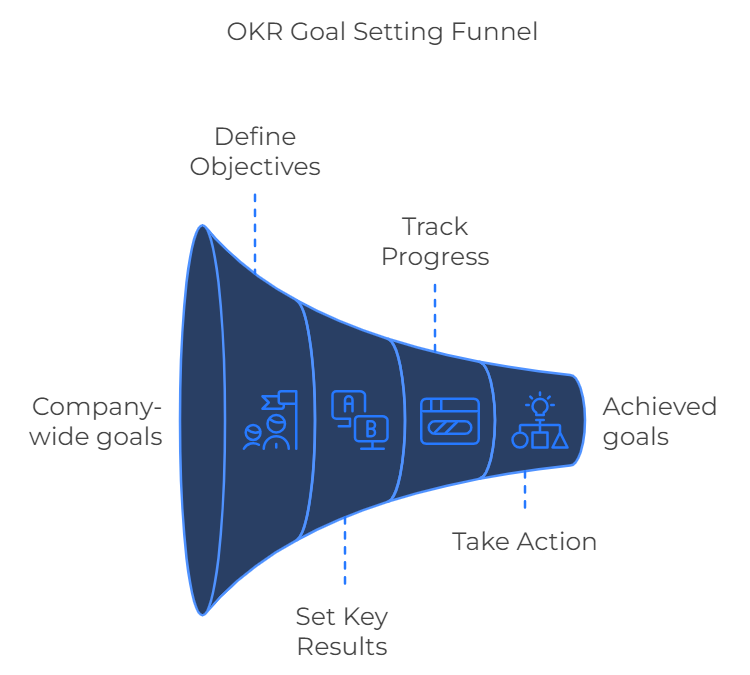Lost in the Acronyms-OKR, KPI & KRA? Let’s Understand
Everything demands a result! Whether it’s your high school, a southern derby soccer match, or an introspection. The same demands living a corporate life. The company wants to know your progress. How well are you doing? And what is the result? Depending on the same, the metrics were found that calculate your work, and they are OKR, KPI, and KRA. So, let us find out what are OKRs, KPIs, and KRAs.
Results are very important for you too! The reason is that you can find out where you are lacking and where you are doing well. In this way, you find the areas you need to emphasize more and have scope for improvement. To find the results of the goals set, OKR, KPI, and KRA came into the role. Today’s hyper-competitive business world requires you to think smarter, faster, and more strategically. If you want to thrive, you need to focus on the things that matter and measure their impact. This blog post aims to help you understand OKRs, KRAs, and KPIs as they are all important business management metrics. Whether your company is just starting or you’re an experienced CEO – reading this article will be useful for everyone. Keep reading to discover everything there is to know about these three essential metrics.
The acronyms are as follows:
- OKR – Objective and Key Results
- KRA – Key Results Area
- KPI – Key Performance Indicator
Let’s find out what these metrics are for.
OKR (Objective and Key Results)
OKRs stand for Objectives and Key Results. These are popular management reporting metrics that help CEOs (and other managers) to set ambitious yet achievable goals, track progress towards them, and take action when something needs to be changed. Objectives are the company-wide goals that have been identified as the most important for the coming period.
For example, ‘Increase client retention by 10%’ or ‘Build a new product that has a $1 million lifetime value’ are examples of objectives. Key results are the specific, measurable, and time-bound metrics that are used to measure progress towards the objectives. For example, ‘Close 30% more leads every month’ or ‘Build the new product in 5 months are examples of key results. In a nutshell, OKRs are used to determine what’s important for the company and help them set goals to achieve it. The metrics that are used to measure the desired outcomes are called Key Results


KRA (Key Results Area)
KRAs are KPIs that are specific to the departments or teams. They are metrics that help managers to measure how well their department is performing compared to the budgeted goals. KRAs are similar to OKRs, but they are used at the team level instead of the company level. Managers use KRAs to set goals and measure the performance of their teams. The KRAs are different in each department, although sometimes they can be the same as the company-wide metrics. For example, in the sales department, the KRA might be ‘Increase sales by 10%’, while in the marketing department, it could be ‘Increase leads by 30%’.
KPI (Key Performance Index)
KPIs are Key Performance Indicators that show whether the business is performing well or not. KPIs are usually used in a broader sense to refer to any business metrics. KPIs can be financial metrics like profit, revenue, net profit margin, churn rate, etc., but also non-financial metrics like revenue per customer, customer satisfaction, etc. This is why it’s important to track the metrics that are relevant to your business. While OKRs are used to track company-wide metrics, KRAs are used to track the metrics of departments, and KPIs are used to track the metrics of the entire business.
Integrating Metrics with Teams
For a successful business, it’s essential that every team within the organization, from the Sales Team to the Marketing Team, aligns their daily efforts with the broader objectives of the company. OKRs help in this by providing a clear goal-setting framework, where each team’s objectives feed into the company’s overall targets. For instance, while the Sales Team may focus on KPIs like ‘Increase monthly sales by 15%’, the Marketing Team might prioritize KPIs related to ‘Enhancing brand visibility by 20%’. This alignment ensures that all teams work cohesively toward the company’s long-term vision.
The Role of Metrics in Long-Term Success
Tracking these metrics in real-time allows businesses to make informed decisions swiftly, ensuring they remain on track to achieve their long-term goals. For example, customer retention is a critical KPI that directly impacts long-term profitability. By regularly measuring and analyzing this metric, businesses can implement strategies to retain more customers, thus ensuring sustained growth. Similarly, KRAs focused on customer service or product development can highlight areas needing improvement, driving better results over time.
Evolving Your Metrics
As your business matures, so will the metrics that matter. Goal-setting frameworks like OKRs provide flexibility, allowing you to evolve and adapt your metrics as your company’s priorities shift. Perhaps your current objective is to ‘Expand into new markets’, with key results centered around customer acquisition in these new regions. Over time, as this objective is met, your focus might shift towards ‘Maximizing market share’ or ‘Increasing Objective Increases in product quality’. Continuous tracking and adjustment of these metrics are crucial for maintaining momentum and achieving long-term success.
Bottom line
These three metrics are important for any business to track its performance and stay on the right track toward its goals. Depending on the goals you have for your business, you will choose different metrics to track. It’s important to keep monitoring what’s happening in your business and make changes when needed.






